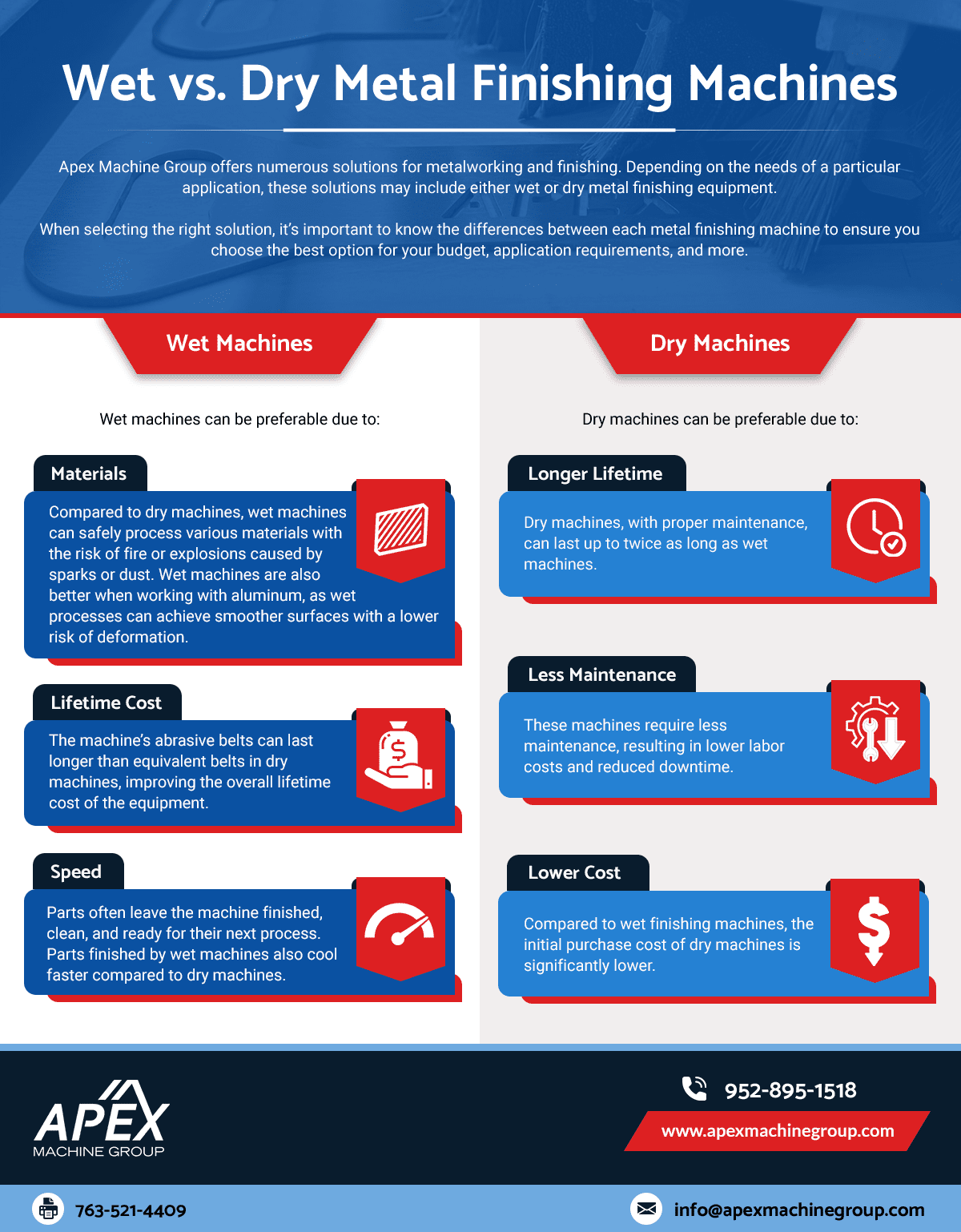Apex Machine Group offers numerous solutions for metalworking and finishing. Depending on the needs of a particular application, these solutions may include either wet or dry metal finishing equipment. When selecting the right solution, it’s important to know the differences between each metal finishing machine to ensure you choose the best option for your budget, application requirements, and more.
Wet vs. Dry Metal Finishing Machines
Based on what you require for your metalworking application, you can choose from wet or dry metal finishing machines.
Wet Machines
Some applications are better suited to wet metal finishing machines. These machines can perform a wide array of processes such as deburring, polishing, and dross removal, which can also often be performed by dry metal machines.
Wet machines can be preferable due to:
- Materials. Compared to dry machines, wet machines can safely process various materials with the risk of fire or explosions caused by sparks or dust. Wet machines are also better when working with aluminum, as wet processes can achieve smoother surfaces with a lower risk of deformation.
- Lifetime cost. The machine’s abrasive belts can last longer than equivalent belts in dry machines, improving the overall lifetime cost of the equipment.
- Speed. Parts often leave the machine finished, clean, and ready for their next process. Parts finished by wet machines also cool faster compared to dry machines.
Some considerations for choosing a wet metal or wood finishing machine include:
Higher One-Time and Lifetime Cost
These machines require frequent maintenance and tend to cost around 30% more than dry machines, regardless of the manufacturer. Although these machines feature higher upfront costs, they make up for it in convenience and quality. However, it’s important to not that wet machines typically only last about half as long (12-15 years) as dry machines.
Maintenance Required
Wet deburring machines require strict maintenance protocols, as certain materials are compatible with certain coolant mixtures. If you don’t maintain the right mixtures of water and lubricant, corrosion could develop. For instance, systems using regular unfiltered tap water may contain residue that the water leaves behind as it evaporates, including calcium, sodium, sulfur, and magnesium. These chemicals must be carefully monitored, as too much buildup can lead to gumming and rust. This maintenance can also introduce additional labor costs for MRO employees.
Variable Costs
To maintain wet metal finishing machines, systems require regular monitoring of the coolant’s chemical makeup, along with daily cleaning. Doing so helps maintain top performance. However, some models of wet metal finishing machines include stainless steel in certain areas to avoid corrosion. Wet systems also minimize hazards when working with varying metals, offer longer abrasive belt life, and eliminate the need for a dust collector.
Dry Machines
While wet metal finishing machines work with many applications, some may benefit more from dry machines.
Dry machines can be preferable due to:
- Longer lifetime. Dry machines, with proper maintenance, can last up to twice as long as wet machines.
- Less maintenance. These machines require less maintenance, resulting in lower labor costs and reduced downtime.
- Lower cost. Compared to wet finishing machines, the initial purchase cost of dry machines is significantly lower.
Other considerations when choosing to go with a dry metal or wood finishing machine include:
Lower One-Time and Lifetime Cost
Dry machines tend to require less diligent maintenance. At the same time, dry metal finishing equipment often provides a longer service life and is less expensive to buy and operate. This can sometimes overshadow the higher variable costs associated with replacing dry machine abrasive belts, which wear out faster than their wet machine counterparts.
Maintenance Required
While maintenance isn’t as difficult with dry machines as with wet machines, it’s still a critical step in keeping dry equipment in great condition. It’s also necessary to clean the equipment between material changes to properly maintain it.
Safety Considerations
Keep in mind that aluminum dust can accumulate in the machine’s ductwork, in which case a single spark can ignite a serious fire. To prevent this, equipment operators must properly maintain and clean the machinery. If systems mix metal materials together, you will also need to remove fire hazards through the use of a wet dust collector. The water in the dust collector functions as a filter to collect debris. This debris then settles in the collector’s base, where operators can remove it with a scoop.
Why Apex Machine Group?
Both wet and dry metal finishing machines have unique benefits and disadvantages that make them suitable for different applications. While wet machines tend to be more expensive and maintenance-heavy, they can give you the results you need. Dry machinery is also capable of providing great results, but you will still need to perform maintenance and cleaning to keep the machine safe and fully functional.
At Apex Machine Group, we offer a selection of quality wet finishing machines and dry finishing machines. These machines provide solutions for a variety of applications, including deburring, finishing, graining, oxide removal, edge-radiusing, dimensioning, and grinding. Depending on the materials involved, we also offer a variety of other equipment to ensure you get the results you desire.
Let us be your guide to metal finishing and help you select the right solution based on your unique needs. To learn more about our equipment and capabilities, contact us today.
